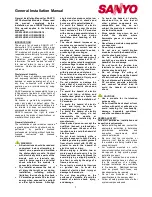
General Installation Manual
2
INSTALLATION
General
•
Please read this guide completely
before installation or use of the
modules.
This
section
contains
electrical
and
mechanical
specifications needed before using
your SANYO PV modules.
•
Modules should be firmly fixed in
place in a manner suitable to
withstand
all
expected
loads,
including wind and snow loads.
•
The drilling and addition of ground
holes is permitted, but should be
avoided whenever possible to avoid
damage to the module. When
additional
ground
holes
are
necessary, they must not penetrate
the inner side of the aluminum frame.
Caution
is
advised
to
avoid
accidentally drilling, scratching, or
penetrating the back sheet surface of
the module. If required, it is
recommended
to
add
additional
ground holes to the outer aluminum
lip area of the module. In such case,
additional ground holes must be at
least 65
㎜
away from any frame
corner.
•
For a non-integral module or panel, a
statement that the assembly is to be
mounted over a fire resistant roof
covering rated for the application.
•
Appropriate material should be used
for mounting hardware to prevent the
module frame, mounting structure,
and hardware itself from corrosion.
•
Install modules where they are not
shaded by obstacles like buildings
and trees. Especially pay attention to
avoid partially shading the modules
by objects during the daytime.
•
Please
contact
your
SANYO
Authorized
Representative
with
questions regarding mounting profiles
for modules if needed.
Notes on Installation
•
Clearance between the roof surface
and module frame is required to allow
cooling air to circulate around the
back of the module. This also allows
any condensation or moisture to
dissipate. Install modules so that air
can circulate between the roof and
the module.
•
We recommend installation methods
shown in Figure 1. In some areas,
local electrical codes may govern the
installation and use of PV modules.
Operating Conditions
SANYO recommends that modules be
operated within the following Operating
Conditions. An installation location with
conditions
beyond
the
Operating
Conditions
or
with
other
Special
Conditions (see below) should be avoided.
Operating Conditions of SANYO modules
are as follows:
1) The modules should be operated only
in terrestrial applications. No space or
other Special Conditions (see below).
2) The ambient temperature should be
within –20°C (-4°F) to 40°C (104°F).
3) The relative humidity should be within
45% to 95%.
4) The installation place should be less
than 1,000m (3,280ft) above sea
level. Installations more than 1,000m
(3,280ft) are allowed only if the wind
pressure load for a module is less
than 2,400N/m
2
(50PSF).
Special Conditions
1) The
ambient
temperature
and
installation place are different from
the
recommended
Operating
Conditions.
2) Salt damage is severe at the
installation place.
3) Hail and snow damage is excessive
at the installation place.
4) Sand and dust damage is excessive
at the installation place.
5) Air
pollution,
chemically
active
vapors, acid rain, and/or soot, etc. are
excessive at the installation place.
SPECIFICATIONS
Notes on Specifications
1) Rated electrical characteristics are
within 10% of the values measured at
Standard Test Conditions (STC).
Irradiance of 1000W/m
2
, 25
o
C cell
temperature,
and
solar
spectral
irradiance per IEC 60904-3.
2) Under
normal
conditions,
a
photovoltaic module may experience
conditions that produce more current
and/or voltage than reported at
standard component test conditions.
Accordingly, the values of Isc and
Voc should be multiplied by a factor
of 1.25 when determining voltage
ratings, conductor capacities, fuse
sizes, and size of controls connected
to the module output.
3) The current output for the modules
shown
in
the
Specifications
is
measured
at
Standard
Test
Conditions. These conditions may
not be frequently observed in actual
practice.
Application class of product
SANYO HIT PV-modules are applied to
application class A. Application class A for
·
Solar Module
A
Installation (reference)
–
HIP
-
xxxNHE5,
-
xxxNHE5
-
BO2
HIP
-
xxx
NE3,
-
xxxNE3
-
BO
-
2
For questions regarding mounting profiles for modules, please co
ntact your local dealer.
Solar Module
Mounting
Structure Rail
Module
Mounting Structure Rail
M6 Bolt
Spring washer
M6 Nut
Flat washer
Flat washer
A
Spring washer
Section A
-
A
Figure1 : Installation
Solar Module
A
Installation (reference)
For questions regarding mounting profiles for modules, please co
ntact your local dealer.
Solar Module
Mounting
Structure Rail
Module
Mounting Structure Rail
M6 Bolt
Spring washer
M6 Nut
Flat washer
Flat washer
A
Spring washer
Section A-A
























